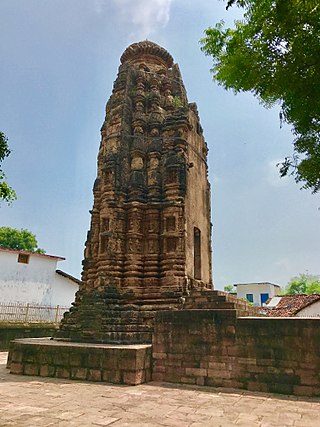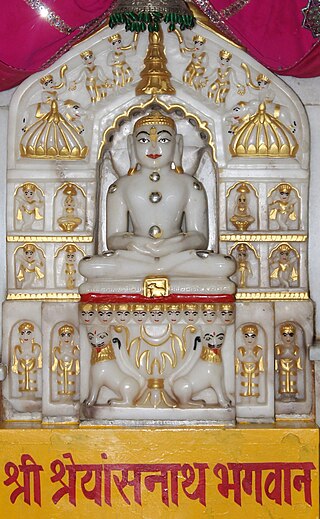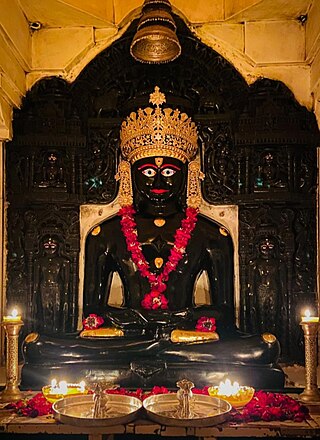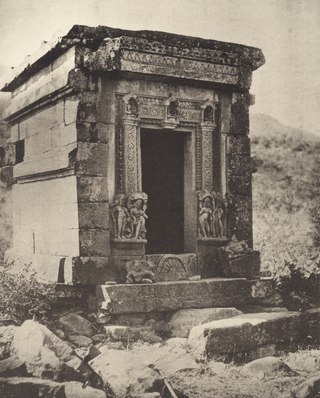
The Dilwara Temples or Delvada Temples are a group of Śvētāmbara Jain temples located about 2+1⁄2 kilometres from the Mount Abu settlement in Sirohi District, Rajasthan's only hill station. The earliest were built by Vimal Shah, a Jain minister of Solanki king of Gurjaratra, Bhima I and additions to the temples were made by Vastupala, Jain minister of Vaghelas of Gurjaratra. They date between the 11th and 16th centuries, forming some of the most famous monuments in the style of Solanki architecture, famous for their use of a very pure white marble and intricate marble carvings. They are managed by Seth Shri Kalyanji Anandji Pedhi, Sirohi and are a pilgrimage place for Jains, and a significant general tourist attraction. The Dilwara temples are regarded as the most impressive among Jain temples in Rajasthan.

Sittanavasal Cave is a 2nd-century Tamil Śramaṇa complex of caves in Sittanavasal village in Pudukottai district of Tamil Nadu, India. Its name is a distorted form of Sit-tan-na-va-yil, a Tamil word which means "the abode of great saints".

Taranga is a Jain pilgrimage center near Kheralu in Mehsana district, Gujarat, India, with two compounds of Jain temples that are important examples of the Māru-Gurjara style of architecture. The Ajitnatha temple, was constructed in 1161 by the Solanki king Kumarapala, under the advice of his teacher, Acharya Hemachandra. Both the main sects of Jainism are represented, with adjoining walled compounds: the Śvetāmbara compound consists of 14 temples in all, and there are also five Digambara-affiliated temples at Taranga hill.

Arang, also known as "The town of temples" of Chhattisgarh, is a block and a Nagar Palika in Raipur District in the state of Chhattisgarh, India. It is situated near the eastern limits of Raipur City and close to Mahasamund City. Arang is an ancient town, which was ruled by the Haihayas Rajput dynasty. It is famous for its many Jain and Hindu temples which belong to the 11th and 12th centuries; these are the Mand Deval Jain temple, the Mahamaya temple, the Panchmukhi temple and the Hanuman temple. Due to the Archaeological finds of a copper plate inscription dated to the Gupta Empire, known as the Arang Plate of Bhimasena II of the clan of Rajarsitulya, has established the town's ancient history as a Hindu and Jain religious centre, which was then under the rule of Hindu kings. The Mand Deval Jain temple is the most ancient of these temples dated to the 11th century where three huge images of Digambara tirthankaras are deified in the sanctum sanctorum; these are carved in black stone and polished.

Panchakuta Basadi is a temple complex located in the Kambadahalli village of the Mandya district, Karnataka state, in southwestern India. It is one of the finest examples of South Indian Dravidian architecture of the Western Ganga variety, related to the Jain faith and iconography.

Shreyansanath was the eleventh Jain Tirthankara of the present age (Avasarpini). According to Jain beliefs, he became a Siddha – a liberated soul which has destroyed all of its karma. Shreyansanatha was born to King Vishnu and Queen Vishna at Simhapuri, near Sarnath in the Ikshvaku dynasty. His birth date was the twelfth day of the Falgun Krishna month of the Indian calendar.

Nemināth, also known as Nemi and Ariṣṭanemi, is the twenty-second tirthankara of Jainism in the present age. Neminath lived 81,000 years before the 23rd Tirthankar Parshvanath. According to traditional accounts, he was born to King Samudravijaya and Queen Shivadevi of the Yadu dynasty in the north Indian city of Sauripura. His birth date was the fifth day of Shravan Shukla of the Jain calendar. Krishna, who was the 9th and last Jain Vasudev, was his first cousin.
The Solar dynasty or Sūryavaṃśa, also called the Ikshvaku dynasty is a legendary Indian dynasty said to have been founded by Ikshvaku. In Hindu literature, it ruled the Kosala Kingdom with their capital at Ayodhya and later at Shravasti. They prayed to their clan deity Surya, after whom the dynasty formed its namesake. Along with the Lunar dynasty, the Solar dynasty comprises one of the main lineages of the Kshatriya varna in Hinduism.

Jainism in North Karnataka flourished under the Chalukyas, Kadamba, Rashtrakutas, and Vijayanagara Empire. Imbued with religious feeling, patronage was extended towards the building of Jain temple and it garnered high repute among the people, particularly the ruling classes and the mercantile community; effectively getting treated as the state religion.

Tirumalai (lit. "the holy mountain"; also later Arhasugiri, lit. "the excellent mountain of the Arha[t]"; Tamil Engunavirai-Tirumalai, lit. "the holy mountain of the Arhar" is a Jain temple and cave complex dating from at least the 9th century CE that is located northwest of Polur in Tamil Nadu, southeast India. The complex includes three Jain caves, two Jain temples and a 16.25-foot-high sculpture of Tirthankara Neminatha thought to date from the 12th century CE that is the tallest Jain image in Tamil Nadu. Arahanthgiri Jain Math is also present near Tirumalai complex.

Uttar Pradesh, a state in north India has a long association with Jainism. Today the state is home to a number of Jain monuments, such as Jain Temples and Jain Tirths. There are around 213,267 Jains in Uttar Pradesh according to the 2011 Census of India.

The Palitana temples, often known only as Palitana, are a large complex of Jain temples located on Shatrunjaya hills near Palitana in Bhavnagar district, Gujarat, India. Also known as "Padliptapur of Kathiawad" in historic texts, the dense collection of almost 900 small shrines and large temples have led many to call Palitana the "city of temples". It is one of the most sacred sites of the Śvetāmbara tradition within Jainism. The earliest temples in the complex date as far back as the 11th century CE.

Jain art refers to religious works of art associated with Jainism. Even though Jainism has spread only in some parts of India, it has made a significant contribution to Indian art and architecture.

Jainism flourished in Goa during the rule of Kadamba dynasty of Karnataka. Broken sculptures of the Jain Tirthankara Suparshvanatha, belonging to the period of the Goan Kadamba ruler Shivachitta Permadi Dev, were discovered in an old Jain temple in Jainkot, Naroa.

There is a group of temples of Jainism on Mount Girnar near Junagadh in Junagadh district, Gujarat, India. While almost all the temples belong to the Śvetāmbara sect, some also belong to the Digambara sect. The hill and some of the temples are considered sacred by both Digambara and the Śvetāmbara branches of Jainism.

Shantinatha temple is a Jain temple located among the Jain temple cluster in eastern Khajuraho in Madhya Pradesh, India. While its main deity is the Jain tirthankara Shantinatha, it includes 18 shrines with numerous Jain images.

The Jain Temple complex is group of 31 Jain temples located at Deogarh in Lalitpur district, Uttar Pradesh built around 8th to 17th century CE. The Jain complex in Deogarh are protected by the Archaeological Survey of India (ASI), and managed through its Northern Circle Office located in Lucknow. ASI maintain an archaeological museum at the Deogarh site, which is noted for its treasured archaeological sculptures.

Sirpur Group of Monuments are an archaeological and tourism site containing Hindu, Jain and Buddhist monuments from the 5th to 12th centuries in Mahasamund district of the state of Chhattisgarh, India. Located near an eponymous village, it is 78 kilometres (48 mi) east of Raipur, the capital of the state. The site is spread near the banks of the river Mahanadi.

Gadarmal Devi temple is a Hindu and Jain temple at Badoh village of Vidisha, Madhya Pradesh. Also called Gadarmal Temple of the Mothers, it is one of India's yogini temples. It has 42 niches for yogini statues, unusually arranged in a rectangle; it must originally have been hypaethral.

The Pataini temple or Pataini devi temple is a 5th century Jain temple constructed during the reign of the Gupta Empire and located near the town of Unchehara in Madhya Pradesh, India.
























